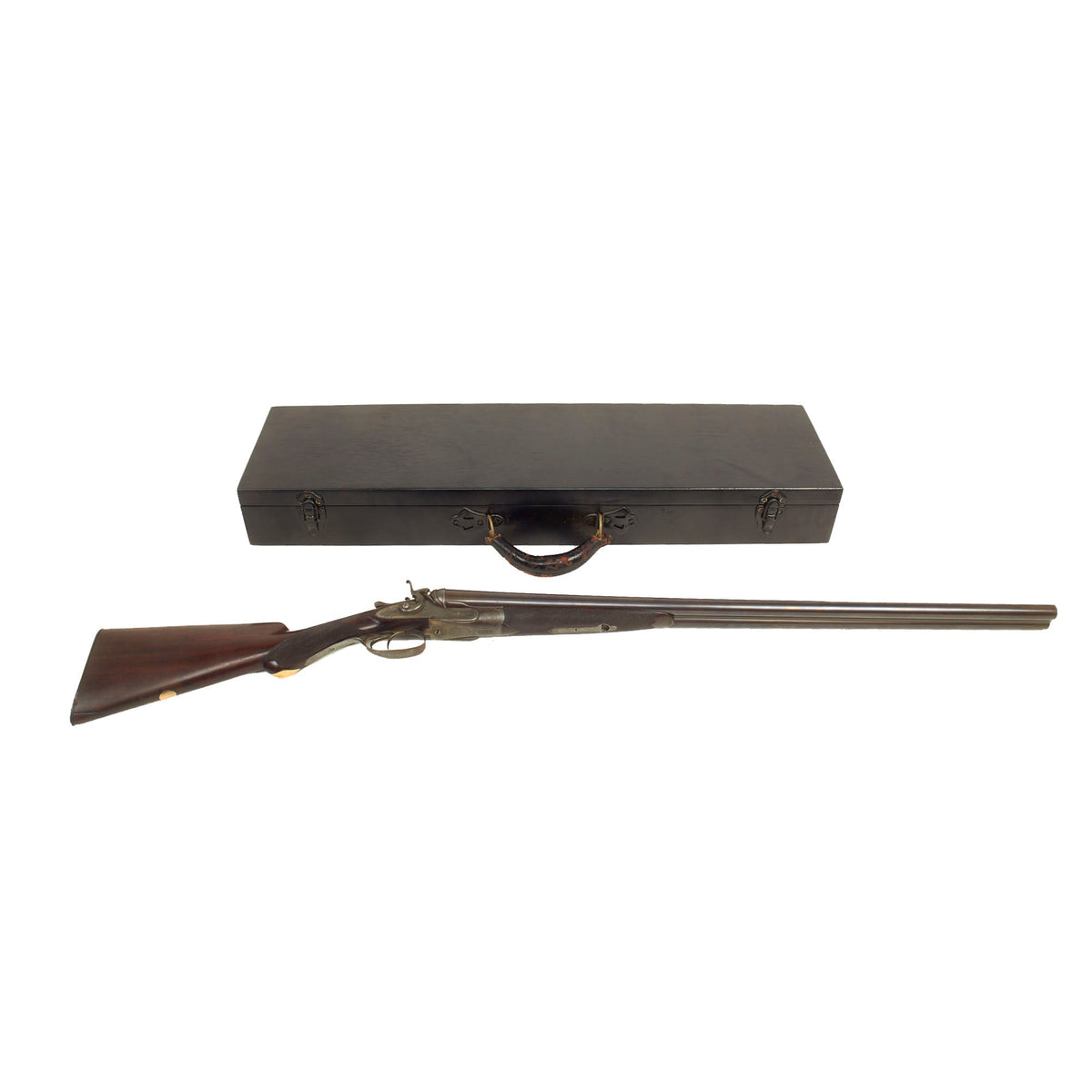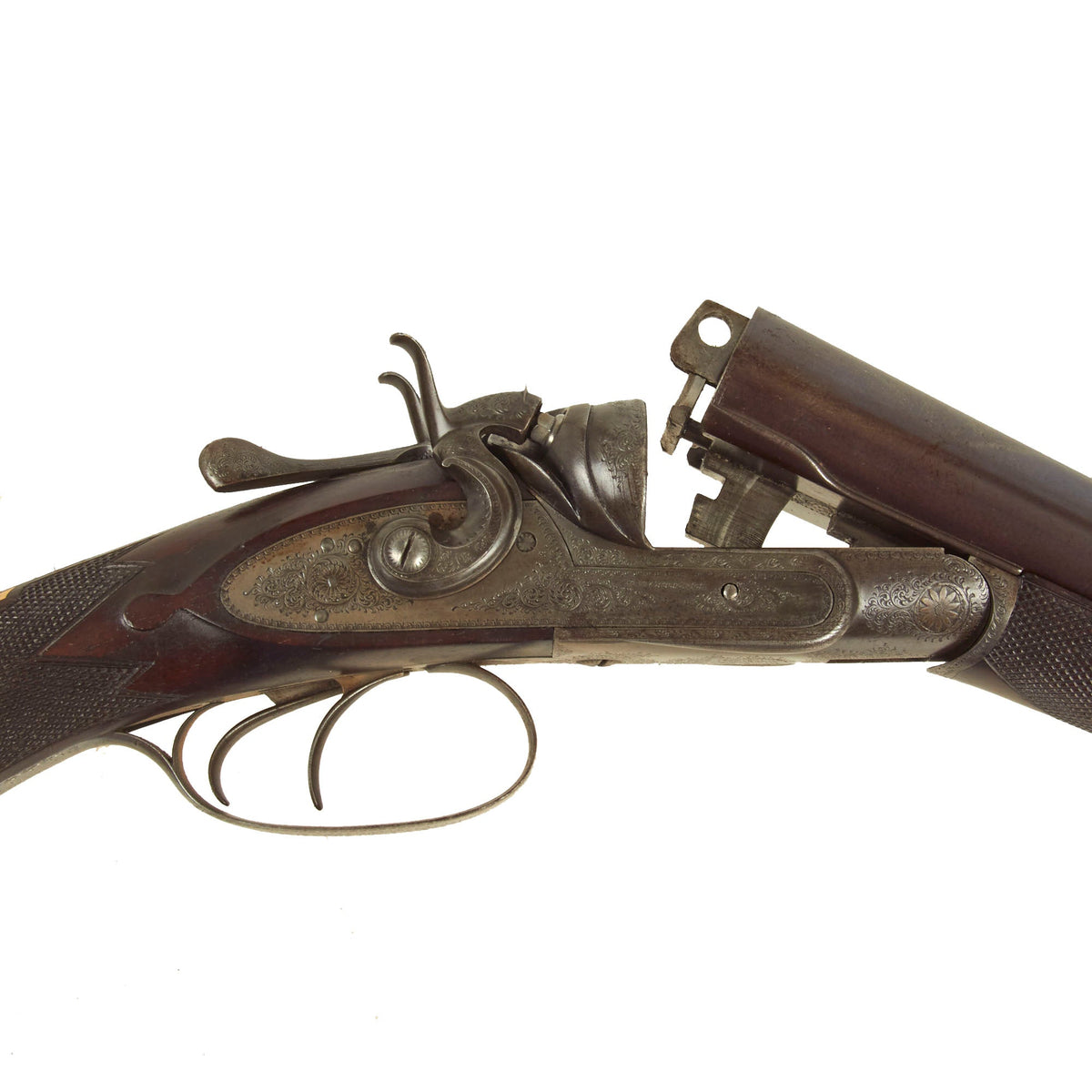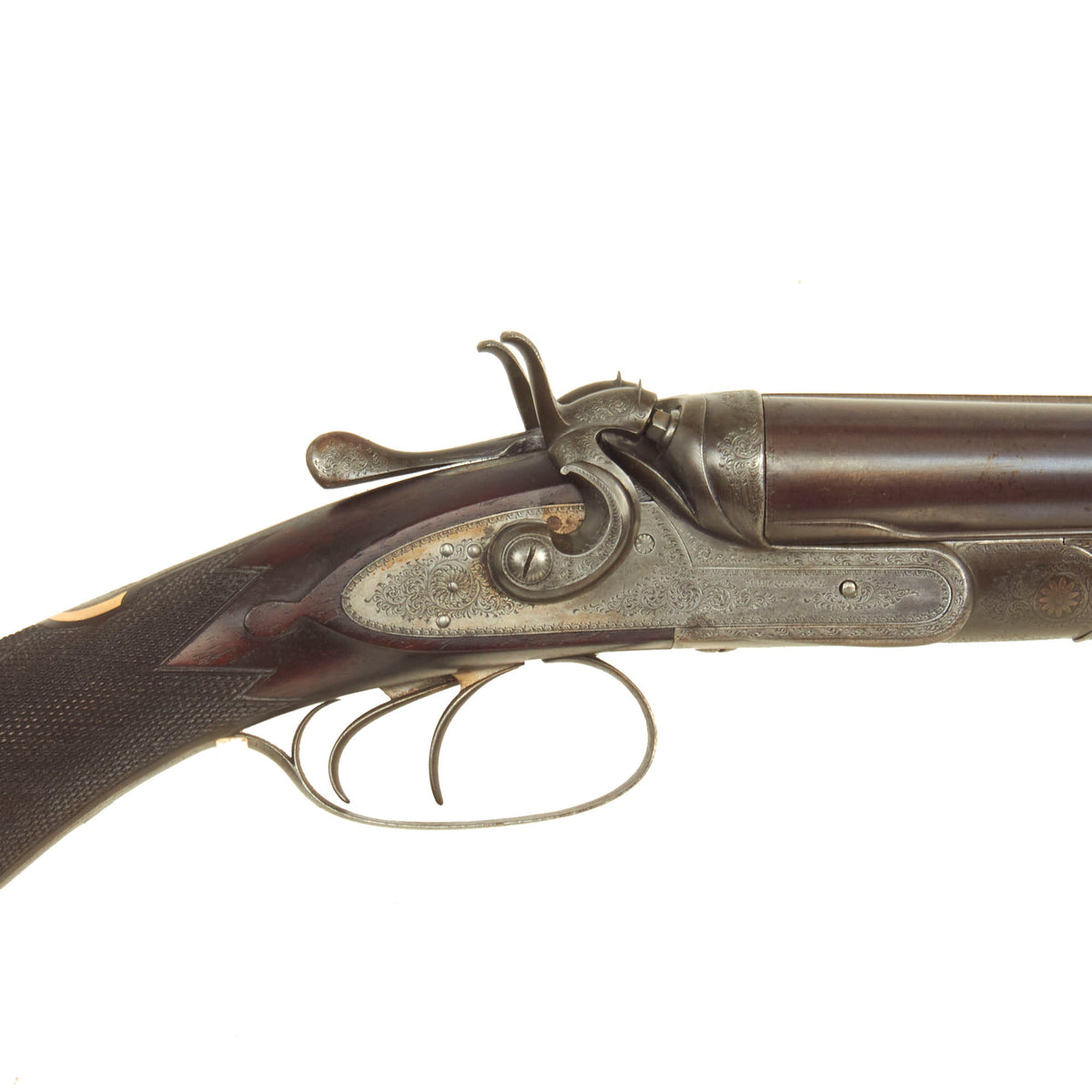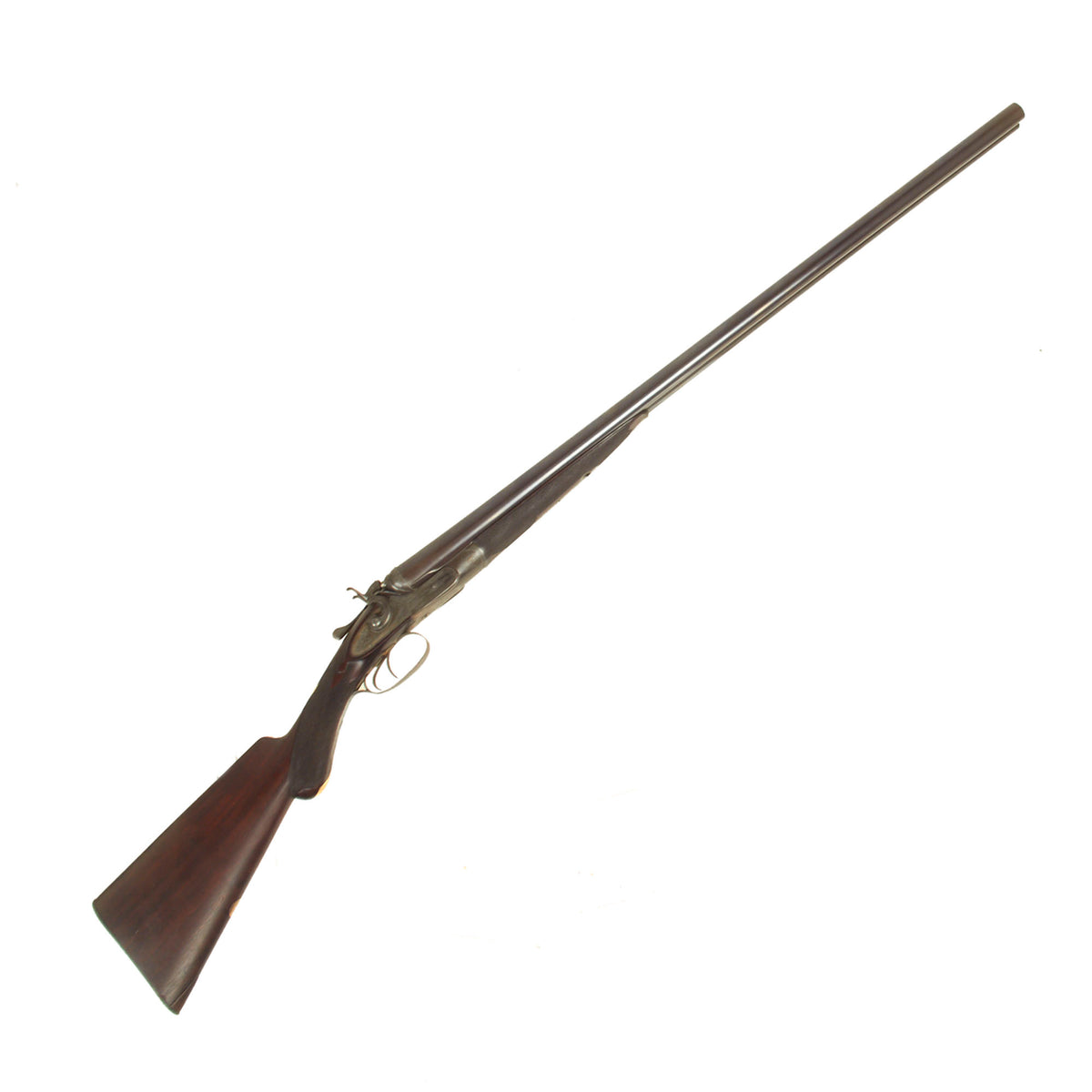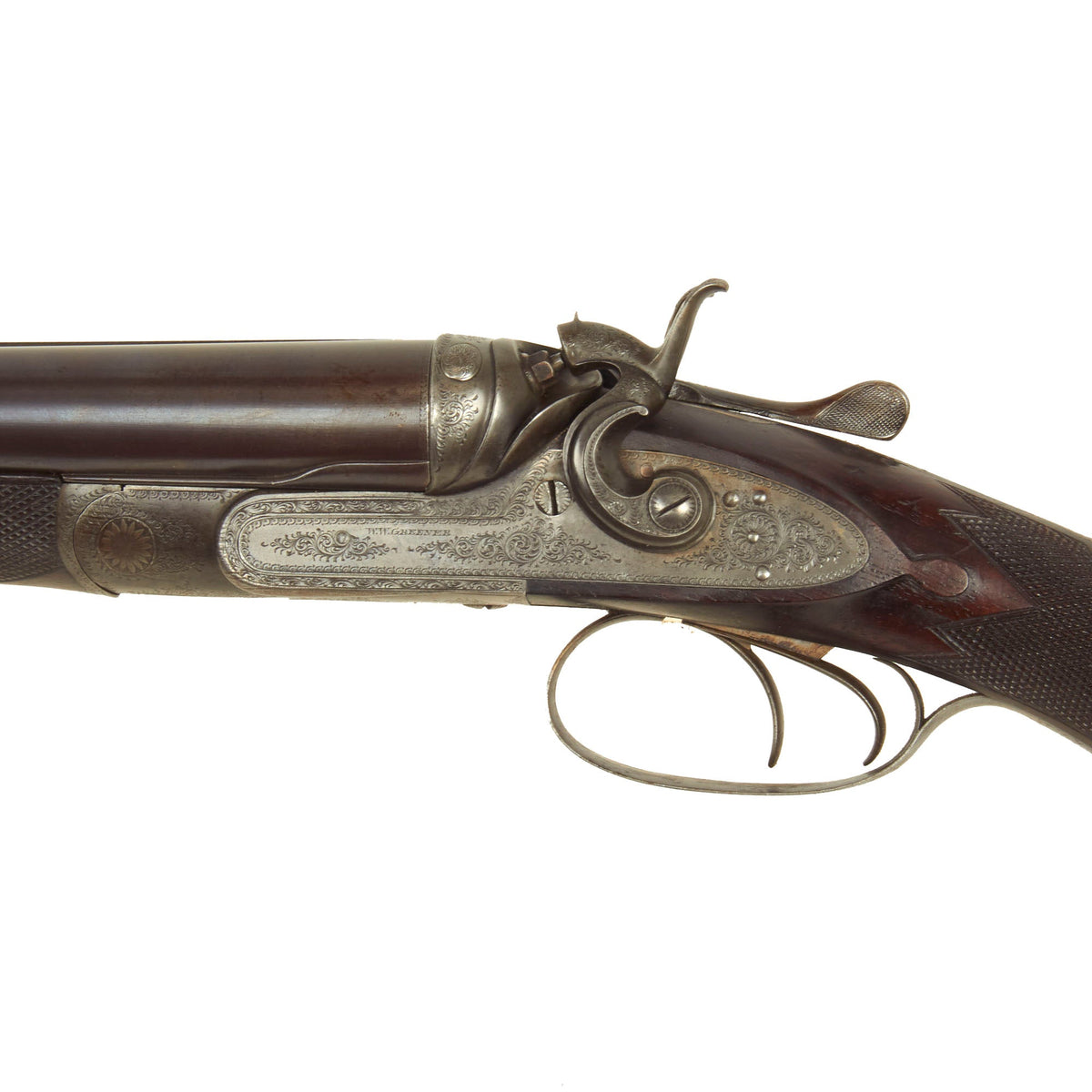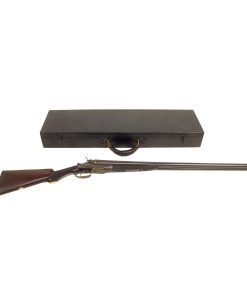Original British Cased 14 Gauge Double Barrel Hammer Shotgun Made by W.W. Greener in 1876 – Serial 16512 Original Items
$ 1.995,00 $ 498,75
Original Item: Only One Available. Here we have a fantastic ornately engraved British-made Double Barreled Hammer shotgun, possibly intended for the large U.S. import market. It is marked on both lock plates by maker W.W. GREENER, a very well-known and respected British gun making firm, whose history reaches back almost 200 years! William Greener had been working for the prominent London gun maker Joseph Manton, before returning to his home in Newcastle to found the W. Greener Company in 1829. In 1844, having realized that almost all of his supplies were coming from Birmingham, he moved his production to the city, and during 1845-58 was appointed gunmaker to Prince Albert, the Prince-Consort of Queen Victoria. The company became quite prosperous at this time, and opened a factory on “Rifle Hill” in the Aston area of Birmingham. However, William Greener was a very firm believe in muzzle loading firearms, and refused to make any breechloading guns.
His son William Wellington Greener was not of the same mind, and struck out on his own, to found the W.W. Greener Company, producing his first breechloader in 1864. After his father passed away in 1869, the two companies were merged under the W.W. Greener name, after which they made a full line of high quality breech loading guns. The company was credited with advancing many innovations during the 19th century, including some innovative breech locking mechanisms, such as the cross bolt, and later “Treble Wedge-Fast” breech action. The treble wedge-fast was one of the strongest breech actions ever invented and was widely copied by other manufacturers, after the patent rights expired.
However, the company may be best known for perfecting and popularizing the idea of a “choke” in the bore of a shotgun, which helps to increase the effective range. The idea had first been put forth by others in both the U.S. and the U.K., however it was Greener that truly experimented with the system to make it work like it was supposed to. The company made some quite strong claims about the effectiveness of their system, enough so that considerable controversy was generated. After a public trial involving various types of shotguns, the Greener Choke bore guns dominated, and would go on to win gun trials in the U.K. as well as the U.S., resulting in much fame for the company.
This is a great example of one of the relatively early production shotguns made right during the period when the trials were being conducted. It is marked on the trigger guard, the top of the receiver under the barrel, and on the bottom of both barrels with matching serial number 16512. Consulting known W.W. Greener records indicate that serial numbers 16001 through 17500 were produced in 1876. The shot gun definitely looks to have had the barrel refinished at some time, which has made the markings faint, but we can still make out the breech patent information on the far rear of the barrel assembly:
PATENT TREBLE
No. 3084
WEDGE-FAST
The barrel strap next to this is a bit more worn, but we can still make out the original engraving:
W.W. GREENER ST. MARY’S WORKS BIRMINGHAM. WINNER OF THE LONDON GUN TRIALS. 1875.
This is the correct early pattern markings before later wins at the gun trials in 1877, 1878, and 1879. The bottoms of each barrel bear the correct Birmingham proof marks, including the CROWN / CROSSED SCEPTERS / BPC “proof” and CROWN / CROSSED SCEPTERS / V “viewed” marks. There is also the CROWN / BP definitive proof, and a 14 marking, indicating “13 bore” or about .693″. There are additional W.W. GREENER / PATENT markings, as well as some others which we do not recognize.
This fantastic DOUBLE BARREL 14 gauge Hammer Shotgun presents very nicely, still showing crisp engraving on the lower receiver / action area, which has almost certainly NOT been refinished. It is truly a beautiful example, with copious foliate engraving on all components. The butt stock is high quality figured walnut, which has a checkered “pistol grip”, which is still in excellent condition. There are also brass escutcheons on the bottom of the pistol grip and another on the bottom of the butt stock. There is even a small brass ornamentation around the tang of the receiver. The butt pad is a lovely piece of checkered and carved horn. The only real deficiency is that the toe of the butt stock has been replaced, and a section of the butt pad replaced with a silver insert.
The fore stock is lovely, also made of walnut and almost fully checkered, except for the front near the horn fitting and the rear near the metal fitting. It has a lever that releases it from the bottom of the barrel. Originally intended for hunting and home defense these saw a lot of use on the Frontier and were supplied to both Stage Coach Lines and Railroads. The action still functions correctly, with ejection and dry firing. We checked the bore, and it is bright and shiny, showing very little use.
The shotgun comes complete with a custom wood case, which was originally probably varnished on the exterior, but over time it became worn, and then was painted satin black overall. It is however still lined in purple velvet, and has an original W.W. Greener label on the inside, which has the correct addresses for the period:
W. W. Greener
St. Mary’s Row
Birmingham & 29 Pall Mall
London, S. W.
The case measures 31 1/2″ x 8 1/2″ x 4″, and has two functional latches on the front, as well as a nice carry handle. Inside the case is a very nice period multi-piece cleaning rod.
A truly lovely antique hammer shotgun by a very famous maker, made right during the period when they achieved true fame for their designs! Complete in a custom wood case, this lovely piece is ready to research and display!
Specifications-
Year of Manufacture: 1876
Caliber: 14 gauge / bore – 3 inch chambers
Cartridge Type: Centerfire Cartridge
Barrel Length: 30 Inches
Overall Length: 46 Inches
Action type: Back Action Locks with External Hammer
Feed System: Top Break with Top Lever
NOTE: International orders of antique firearms MUST be shipped using UPS WW Services (courier). USPS Priority Mail international will not accept these. International customers should always consult their country’s antique gun laws prior to ordering.
Fast Shipping with Professional Packaging
Thanks to our longstanding association with UPS FedEx DHL, and other major international carriers, we are able to provide a range of shipping options. Our warehouse staff is expertly trained and will wrap your products according to our exact and precise specifications. Prior to shipping, your goods will be thoroughly examined and securely secured. We ship to thousands clients each day across multiple countries. This shows how we're dedicated to be the largest retailer on the internet. Warehouses and distribution centres can be located throughout Europe as well as the USA.
Note: Orders with more than one item will be assigned a processing date depending on the item.
Before shipping before shipping, we'll conduct a thorough inspection of the items you have ordered. Today, the majority of orders will be delivered within 48 hours. The delivery time will be between 3-7 days.
Returns
The stock is dynamic and we cannot completely manage it because multiple stakeholders are involved, including our factory and warehouse. So the actual stock may alter at any time. It's possible that you may not receive your order once the order has been made.
Our policy is valid for a period of 30 days. If you don't receive the product within 30 days, we are not able to issue a refund or an exchange.
You can only return an item if it is unused and in the same state as the day you received it. You must have the item in its original packaging.
Related products
Uncategorized
Uncategorized
Uncategorized
Uncategorized
Uncategorized
Uncategorized
Australian WWII Owen MK1 Machine Carbine SMG Custom Fabricated Replica with Sling Original Items
Uncategorized
Band of Brothers ORIGINAL GERMAN WWII Le. F.H. 18 10.5cm ARTILLERY PIECE Original Items
Uncategorized
Uncategorized
Angolan Rebel 1970s era 60mm Inert Display Mortar from Angolan Civil War Original Items
Uncategorized
Uncategorized
Uncategorized
Uncategorized
Uncategorized
Uncategorized
Uncategorized
Armoured Fighting Vehicles of the World: AFVs of World War One (Hardcover Book) New Made Items
Uncategorized
Uncategorized
